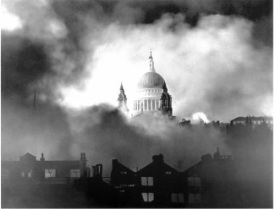How civilian life was changed by The Blitz

The Blitz took place between 7 September 1940 and 10 May 1941.
Gas masks
People in Britain were very affraid of a new, nasty weapon- gas. They were worried that Germany would drop gas from areoplanes, therefore, everyone was issued with a gas mask. A total of 38 million were handed out and these needed to be taken everywhere. Many people were sick due to the smell of rubber and disinfectant. Leaflets were also sent to every household with instructions for what to do if there was a gas attack. So children would not be frightened, they were given either a Mickey Mouse or Donald Duck mask. Also, babies had speical masks as they could not breathe for themselves in a mask. The whole baby sat in a mask and an adult would pump air into it during a raid. If the adult died, so would the baby.
Black outs
Black outs were introduced on the 1st September 1939- just two days before the war was declared. This meant that people were not allowed to have lights on at night. The reasoning for this was that German pilots would know were to drop bombs if lights were on. Many people bought thick, dark curtains or stuck brown paper on their windows. In some factories, they painted the windows black in order to carry on working at night with the lights on. White strips were painted on pavement kerbs and lamp posts to help people find their way in the dark. Originally no car headlights were allowed, but this was lifted quickly as there were lots of accidents resulting in deaths- they were only allowed with hoods over them.
Air Raid Shelters
At the start of a bombing raid a wailing siren sounded, this sent most people towards public shelters. However, 400,000 Anderson shelters were distributed- they were dug into the garden and covered with earth. They were not designed to protect you from direct impact from bombs, instead they were there to protect you from falling brickwork etc. In more urban areas there were large concrete shelters with curved roofs erected. Many people, however, had no shelters, especially in city centres and flats. This meant they either used public shelters or moved to friends and relatives who had shelters during raids. Some people used a Morrison shelter- this was a metal cage placed under a dining table. Many Londoners used the underground tube stations during The Blitz as they felt it was safer. However, it was estimaited that 60% of Londoners stayed in their homes during The Blitz.
Gas masks
People in Britain were very affraid of a new, nasty weapon- gas. They were worried that Germany would drop gas from areoplanes, therefore, everyone was issued with a gas mask. A total of 38 million were handed out and these needed to be taken everywhere. Many people were sick due to the smell of rubber and disinfectant. Leaflets were also sent to every household with instructions for what to do if there was a gas attack. So children would not be frightened, they were given either a Mickey Mouse or Donald Duck mask. Also, babies had speical masks as they could not breathe for themselves in a mask. The whole baby sat in a mask and an adult would pump air into it during a raid. If the adult died, so would the baby.
Black outs
Black outs were introduced on the 1st September 1939- just two days before the war was declared. This meant that people were not allowed to have lights on at night. The reasoning for this was that German pilots would know were to drop bombs if lights were on. Many people bought thick, dark curtains or stuck brown paper on their windows. In some factories, they painted the windows black in order to carry on working at night with the lights on. White strips were painted on pavement kerbs and lamp posts to help people find their way in the dark. Originally no car headlights were allowed, but this was lifted quickly as there were lots of accidents resulting in deaths- they were only allowed with hoods over them.
Air Raid Shelters
At the start of a bombing raid a wailing siren sounded, this sent most people towards public shelters. However, 400,000 Anderson shelters were distributed- they were dug into the garden and covered with earth. They were not designed to protect you from direct impact from bombs, instead they were there to protect you from falling brickwork etc. In more urban areas there were large concrete shelters with curved roofs erected. Many people, however, had no shelters, especially in city centres and flats. This meant they either used public shelters or moved to friends and relatives who had shelters during raids. Some people used a Morrison shelter- this was a metal cage placed under a dining table. Many Londoners used the underground tube stations during The Blitz as they felt it was safer. However, it was estimaited that 60% of Londoners stayed in their homes during The Blitz.
Created by Jamie McMurtrie
2011 ©
2011 ©
